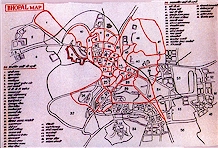BHOPAL GAS TRAGEDY RELIEF AND REHABILITATION THE TRAGEDY On a cold wintry night of December, 2nd /3rd December, 1984, when the residents of capital city of Bhopal went to their beds, they had no inkling that many of them were doing so for the last time. Not far from them in the factory of Union Carbide (India) Limited, a chemical reaction had already started to that end. At around midnight, this chemical reaction culminated in the leakage of deadly Methyl Isocyanate (MIC) gas from one of the tanks of the factory. A cloud of gas gradually and surely started descending and enveloping the city in its lethal folds. And soon all hell broke loose. The city of hills and lakes turned into a gas chamber. Bhopal was witnessing the worst ever industrial disaster. THE AFTERMATH On the morning of December, 3, the whole world learnt about the holocaust in shocked disbelief. The tragedy took an immediate toll of about 3000 innocent lives and left thousands and thousands of innocent citizens physically impaired or affected in various degrees. Live stock were killed, injured and infected. Business were interrupted. Environment was polluted and the ecology affected with flora and fauna disturbed. Such was the enormity of the tragedy that all available instruments in the field of health care, administration and law were found to be inadequate. THE STATE TAKES OVER It became apparent on the very first day of the tragedy that an exclusive administrative machinery was needed to tackle the aftermath of the disaster. An adhoc administrative machinery was created almost immediately and it rendered yeoman service in organizing relief and in restoring confidence among the citizens of Bhopal. The first few weeks, however, demonstrated clearly that the problems created by the disaster would persist for a long time and a special administrative set up would be needed to tackle them. Thus, early in 1985 a Department of Bhopal Gas Tragedy Relief and Rehabilitation was created under the charge of the Chief Minister to undertake the collosal task of relief and rehabilitation. Now the Department is under the charge of a Cabinet Minister of the State Government. A Principal Secretary of the State Government has been entrusted with the Department. A Directorate of Gas Relief and Rehabilitation has been set up to ensure proper coordination between the Department and the field formations. The entire MIC affected area spread over 36 wards and having a population of more than six lacs has been placed under the charge of Director, Gas Relief and Rehabilitation. The disaster area has also been constituted into a medical district under the charge of a Chief Medical Officer to coordinate and supervise the working of all the medical units created to look after the victims of the gas. The administrative machinery created for the disaster area has helped cut down response time drastically. The involvement of public men and the creation of a special administrative machinery has enabled organization of systematic relief and rehabilitation in the disaster area. Voluntary agencies have helped in a big way in providing relief and rehabilitation. They were in the field from the very night of the disaster and they are still at work in the disaster area. There have been no financial constraint in the matter of providing relief and rehabilitation to the affected population. Though the Government of India has stopped financial assistance to the State Government since July 1999, State Government is providing the necessary funds from its own excheque deposite financial constraints. THE PROSPECT The gloom of despondency which hung over the poison-gas disaster area like a pall has now lifted, thanks to the grit and determination of the people who survived the disaster, the timely assistance provided by the State Government and helpful efforts of the voluntary organizations working in the area. Life is once again reasserting itself. The homes and streets which the disaster made desolate, once again hum with activity and a new confidence of fruitful future shows distinctly on the faces of the thousands of people who, underwent a traumatic experience, the like of which few in the world have undergone. LESSONS FROM THE PAST When some more time passes and people overcome their shock and grief and after acquiring perspective, when some complies an account of this tragedy, it will surely stand out in history as the most tragic, the most cruel and the most bizarre calamity perpetrated by man on man. Still the indomitable spirit of the gas victims continues to show : - An assertion of life over death - An
assertion of nature that creates and sustains - An assertion of hope over disaster and despair.
|



